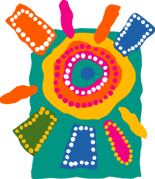
|

In our contemporary world representations are crucial to social relationships. Edward Said, in his important book Orientalism (1978), showed that representations are the outcome of colonial discourses - the ways and means by which we talk about 'the other'. Said demonstrated that ideas and images of the 'other' which are taken to be objective truths are, in fact, cultural constructs based on myths, generalisations and stereotypes. Many contemporary Indigenous artists are challenging these problematic stereotypes.
'Primitive' art
From the late nineteenth century Aboriginal art gradually gained acceptance but it was understood primarily through the concept of 'primitive' art:
The way primitive art was defined was both a misrepresentation and a distancing mechanism (Morphy, 1998, p. 371). |
The category of primitive art allowed the art of Indigenous people worldwide to be admired and Indigenous art became a source of inspiration for European artists. But the problem was, primitivism tended to conflate Indigenous people with nature and locate them back in the distant past.
Objects were collected and displayed in museums and galleries under ethnic and stylistic categories as Aboriginal art, American Indian art, Maori art. Sometimes individual objects were placed alongside works of art by European artists to indicate the importance of primitive art as a source of inspiration for European artists. However, none of these displays gave consideration to the cultural meanings and significance of these objects for the Indigenous artists who made them. |
|

Key concepts |
• assimilation
• primitive art
|
|
|
 |
Read pp. 319-368 |
|
'Authentic' Aboriginality
Morphy shows how representations of Aboriginal people were framed around a benchmark for traditional and authentic Aboriginality located in the remote past or the distant present. As a result Aboriginal art to the north of the continent was elevated to recognition, while Aboriginal people in 'settled' Australia were rendered invisible.
An urban response
Aborigines living in more urbanized areas found that their own distinctive and dynamic culture was overlooked. As Bundjalung artist, Bronwyn Bancroft comments:
For years we were punished for being black and now we're punished for not being black enough.
(cited in Perkins, H. & Lynn, V. 'Blak Artists, Cultural Activists', Australian Perspecta 1993, Sydney, Art Gallery of NSW, pp. x-xii, p. x.) |
|
|
|
|
At the same time assimilation policies expected Aboriginal people to embrace the ideas and values of mainstream Australians. Assimilation policies contributed to representations of Aboriginality by seeking to erase cultural difference. |
|
 |
Reading 1.3 |
Reading 1.4 |
|
Aboriginal stereotypes
Muecke: Available discourses...
Langton: 'Well I heard it on the radio...'
In these readings, linguist Stephen Muecke and Indigenous anthropologist Marcia Langton discuss Aboriginal stereotypes.
Muecke argues that Aborigines are understood through three prevailing discourses:
- anthropological;
- romantic; and
- racist.
|
|
|
| |
Both Muecke and Langton point out that representations of Aboriginality are created and sustained through literature, history and media.
Susan Sheridan (cited in Muecke) argues for another category of Aboriginality: political identity as Aboriginal.
Since the 1970s, as Aborigines have gained access to a higher public profile, greater levels of equality, access to education and policies of self-determination, increasingly they have used art as a form of political protest, forging a new discourse around the politics of cultural identity and difference. |
|
|
| |
How have Aboriginal people intervened in discourses on stereotypes? |
|
Koori, Murri, Nunga, Nyungah
In the 1960s and 1970s Aborigines adopted the collective term Koori as an assertion of independence and unity. Koori had long been used by Aboriginal communities in the southeast before it became public. Nowadays many Aborigines prefer to be called by their own name: Murri in northern New South Wales and Queensland, Nunga in South Australia and Nyungah in southwest Western Australia.
|
|
|
| 
|
Aboriginality and the media
Examine representations of Aboriginality in your everyday life: on radio and television programs, in newspapers, novels and historical texts.
What representations of Aboriginality have you found?
Use the Learnline Discussion Board to share what you have found with other students. |
|
|
| |
|
|
|
 |
Reading 1.5 |
Reading 1.6 |
Reading 1.7 |
|
Richard Bell Scientia E Metaphysica (Bell's Theorem) 2003
Synthetic polymer
paint on canvas 240 x 240cm
Telstra Collection, Museum & Art Gallery of the Northern Territory.
Reproduced with permission of the artist.

Click image for a larger view.
Brisbane-based artist, Richard Bell won the major prize of $40,000 in the 2003 Telstra Art Awards at the Museum and Art Gallery of the Northern Territory with his painting Scientia E Metaphysica (Bell's Theorem). The critical response was very mixed. Several items about this controversy are included in your Reader:
Burton: Winner blasts art whitewash ...
McCulloch: Painting with punch.
White: It's certainly not art ...
In your opinion have Aboriginal stereotypes operated in the media reports about Richard Bell and his painting?
What is Bell's position in relation to these stereotypes? |
|
|
| |
Assignment 1
In addition to your readings and other items you may have found online, review the contributions to the Discussion Board forum on representations of Aboriginality in the media. This may help you to write about both the political protest that informs Richard Bell's painting and the critical response generated by the artist and the work in your first assignment.
See your Unit Information, or go back to Learnline and view Assessments for full details about this assignment task, the marking criteria, and due dates.
|
|
|
| |
 |
|
|
 |